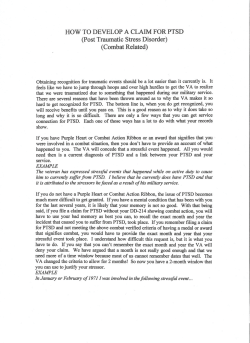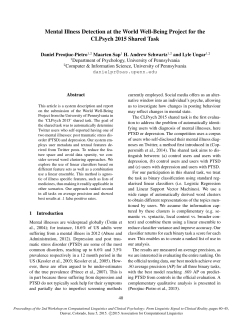
Special Considerations in the Psychotherapeutic Treatment of
Special Considerations in the Psychotherapeutic Treatment of Appalachian Combat Veterans with PTSD Myra Qualls Elder, Ph.D. James H. Quillen Veterans Affairs Medical Center, Mountain Home, TN Disclaimer • The views expressed are my own and do not represent the official views of the Veteran’s Health Administration (VHA). (They wouldn’t let me out to do this presentation unless I put in this slide.) Objectives • Recognize the special challenges posed by Appalachian and military cultural identities • Become familiar with rates of substance use/abuse among combat veterans, and how this affects treatment • Learn about VA-endorsed Evidence-Based Treatments (EBTs) for PTSD ARC’s Map of Appalachia You are 19… PTSD in DSM-V • New Category: Trauma- and Stressor-Related Disorders • Inclusive of “trauma by proxy” • More descriptive of negative cognitive and emotional states as sxs • (American Psychiatric Association: Diagnostic and Statistical Manual of Mental Disorders, Fifth Edition. Arlington, VA, American Psychiatric Association, 2013. Web. [access date: 1 June 2013]. dsm.psychiatryonline.org) PTSD Symptoms After Exposure • Intrusion Sxs: memories, dreams, flashbacks, distress from triggers • Avoidance Sxs • Negative cognitive/emotional states (this is the new sx category in DSM-V): guilt, shame, pervasively negative thinking, detachment, estrangement, anhedonia PTSD Symptoms Continued • Arousal: Anger, reckless/self-destructive behavior (this is new), insomnia, etc. (American Psychiatric Association: Diagnostic and Statistical Manual of Mental Disorders, Fifth Edition. Arlington, VA, American Psychiatric Association, 2013. Web. [access date: 1 June 2013]. dsm.psychiatryonline.org) • The 4 A’s of PTSD: Anger, Alcohol (or opioids, or benzos), Avoidance, Alexithymia Veteran-Specific Dx Questions • When do you do your grocery shopping? • Do you ever eat at a restaurant? Where do you sit? • Is there a gun in your bedroom? How many guns are in your house? Your vehicle? Do you keep them loaded? • How many times a night do you check your window/door locks? • What do you do on July 4th? PTSD Prevalence Data • US projected lifetime risk at age 75 = 8.7%, using DSM-IV criteria (DSM-V) • 12-month prevalence among US adults = 3.5% (DSM-V) • National Vietnam Veterans Readjustment Study (mid-1980s): then-current PTSD rates = 15% men, 8% women • Rates vary across groups and cultures PTSD Prevalence Data II • Millennium Cohort Study: 150K military personnel, data collected 2001-2012 • New onset, deployed, non-combat: 2.1% • New onset, deployed, combat: 8.7% • Current best guess: non-VA users: 15% • VA users: almost 25% • More sxs among Nat’l Guard and Reserves PTSD and SUD • Prevalence stats here on co-morbidity of PTSD and SUDs Tobacco Alcohol Marijuana Cocaine Opioids – Evidence-Based Treatments • Prolonged Exposure (PE) • Cognitive Processing Therapy (CPT) • Cognitive Therapy (CT) • Eye Movement Desensitization and Reprocessing (EMDR) • Stress Inoculation Training (SIT) • Time-limited, structured txs Prolonged Exposure • 90-minutes • 1:1 • 8-15 sessions • Education/Coping Skills • SUDs/in vivo exposure • Imaginal exposure (starts • • • • in Session #3) Emotional processing Homework every session Narrow down exposure to the “hot spots” Final session: process the entire memory again (www.ptsd.va.gov) Does it work? • Yes. Meta-analysis of 13 randomized controlled studies showed that the average PE patient fared better than 86% of patients in control conditions at post-tx. • The catch: no significant diff. b/t this and other EBTs • Another catch: Drop-out rates from 17%-52%; N = 65 vets, and 22 dropped out Now what? • Establish trust: necessary condition • Must be present: minimize distraction, pay attention, have two channels open • Must be engaged: reflective is good, responsive is better, avoid being reactive • Patient must feel as safe as possible, physically and emotionally (ex. windows, pagers, intrusions) Conditions Necessary for Tx • Time: no substitute for this, need it for trust to develop, optimal # of sessions is individual • Genuineness/Positive Regard/Empathy • Culture/Context: Trained to kill, “programmed,” military mindset, masculinity, Appalachian… • Military service = honorable way to individuate from family From Sebastian Junger’s 2010 book, “War,” about the 173rd in Afghanistan • “War is supposed to feel bad because undeniably bad things happen in it, but for a 19-y.o. at the working end of a .50 cal during a firefight that everyone comes out of okay, war is life multiplied by some number that no one has ever heard of. In some ways, 20min of combat is more life than you could scrape together in a lifetime of doing something else.” Early Therapeutic Tasks • Orientation to therapy • Rationale for therapy: “crude oil to gasoline” and reducing avoidance • Possible negative and positive effects of therapy (this is informed consent) • Education about PTSD: “You are not going crazy.” Talk to spouse. • Analogy of physical therapy: “frozen shoulder” Early and Mid-Tx Tasks • Therapeutic deed, not just word • Assessing and creating coping skills FIRST: distraction, relaxation, music, hobbies, social support, exercise • Then, constructing the trauma narrative • Hearing the hard stuff and staying present • Dealing with current life stressors/issues Middle and Later Therapy Tasks • Decreasing affective reactivity: must learn words for emotions (visual to verbal) • Decreasing maladaptive behaviors • Decreasing “stinking thinking:” with vets, all-or-nothing thinking and paranoia very common; shame, blame, guilt • Increasing some integration into society • Increasing self-efficacy: homework Recovery vs. Cure • Balance instillation of hope with realistic view: there will be exacerbations • Current stress, medical problems, travel away from home, media exposure to ongoing war, substance use/abuse • Anniversary reactions • LGBT veterans Potential Pitfalls • Secondary traumatization • Patient dropping out in middle of trauma narrative • Unrealistic expectations • Acting out (patient, not therapist) • Exhaustion (therapist and patient) Therapist Self-Care • Balance case-load • Peer supervision and/or occasional therapy to “offload baggage” • Stable and balanced life away from work • Seeing work as meaningful: Smoky Mountain Service Dogs: www.smokymountainservicedogs.org Does Therapy Work? • 40 years of data on therapy: patient’s rating of the alliance is the best predictor of engagement and outcome • All therapy models show that the most change occurs early in the therapeutic process • Therapy accounts for 13% of variance for change (Wampold, 2001, cited by Miller, 2007) Difficult to Measure Prevented Behaviors • Who did not commit suicide? • Who did not commit homicide? • Who did not drink/use drugs? • Who did not abuse family members? • “Maybe the ultimate wound is the one that makes you miss the war you got it in.” - Sebastian Junger, “War”
© Copyright 2025


















